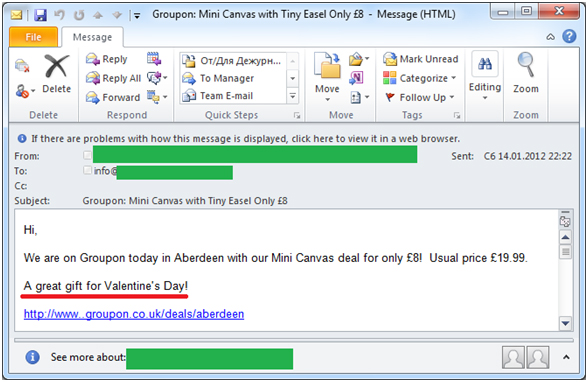
It may not be in the same league as Christmas and New Year, but with every year Valentine’s Day is being exploited more and more by spammers. In the week before it is celebrated this year Valentine’s spam accounted for 0.3% of all spam.
We registered the first Valentine’s spam as far back as 14 January – a whole month before the holiday itself – and it struck us as being rather unusual.
Like the majority of spam mass mailings exploiting the Valentine’s Day theme, this particular mailing was in English. It is a well-known fact that the lion’s share of English-language spam is distributed via partner programs. (Unlike other parts of the world, the practice of small and medium-sized companies ordering spam mailings or sending out spam themselves is not very popular in the USA and most western European countries.) However, the first Valentine’s spam of the year bucked this trend and had nothing to do with a partner program.
This particular offer for Valentine’s Day gifts made use of coupon services.

As you can see from the screenshot, the recipient is urged to buy a small gift for their loved one making use of a discount, an offer which the company made via the major coupon service Groupon.
Coupon services have proved to be a big success around the world. Every day various websites offer special deals on anything from two to several dozen goods or services.
Groupon is one of the biggest Internet projects of its kind and it’s fairly easy to find its promo campaigns online. The site also informs its subscribers about new deals via email. The company that sent out the first Valentine’s spam detected by Kaspersky Lab used an advert for this major portal, the legitimate Groupon email campaign plus spam advertising.
We’ve already noted that for small companies coupon services are fast becoming a credible alternative to spam advertising. Judge for yourself: the method used to spread adverts is the same – via email, but spam filters don’t block legitimate mailings from major Internet resources. Another important advantage is that the firms that offer coupon services are not breaking the law. The size of the mailing may well be less than a spam mailing that a company could order, but the legitimate mailing is sent out to the relevant region and the recipients are genuinely interested in special offers sent by coupon services. As a result, a targeted, legitimate mailing can be more effective than the typical ‘carpet bombing’ associated with traditional spam.
Coupon services have had a noticeable impact on mail traffic and Internet advertising. They have also affected spam. There are now a number of spam categories associated with coupon services.
The first is that of unsolicited mailings by the services themselves. This category of spam is quite rare – the more serious companies don’t want to tarnish their reputation by being associated with spam. However, some start-ups trying to break in to the market are willing to resort to spam in an attempt to attract subscribers or to allow their platforms to be used for promotions by other companies.
Another category of ‘coupon’ spam is that which simply uses the word “coupons” instead of “discounts” to make goods or services more attractive to users. These spam mailings can offer ‘coupons’ for some of the most unexpected items. For instance, the people behind pharmaceutical spam think nothing of offering a small discount on medications and passing it off as a coupon.
A third category of coupon spam includes things like the Valentine’s spam mentioned above. This involves a company whose offers are already available via a coupon service attempting to reach a wider audience by resorting to spam. As I see it, this approach is counterproductive. The majority of users react negatively to spam, and using it to advertise will only do harm to a company’s reputation. This is especially important as many coupon services rely on the trust of their users. Spam, therefore, can actually work against a coupon service, reducing the effect of a promotion instead of enhancing it.
The potential popularity of coupon services carries with it a specific threat. Users of the services tend to leave some money on their account balance so they can spend it at any time on a deal that takes their fancy. Although the amount of money stored on such accounts may not be very much, it is still likely to attract phishing attacks against the customers of coupon services.
So as not to play into the spammers’ hands, or to avoid falling victim to a phishing attack, when using these coupon services, users need to follow three simple rules:
- Don’t open emails from coupon services that you haven’t registered with. On the one hand, this secures you against phishing attacks or mail traffic containing malicious code. On the other hand, if a spammer’s email turns out to be simply a commercial offer, you reduce the number of responses, making the spammers’ work less profitable.
- If an email from a coupon service to which you are registered asks you to verify your account via a link, or to enter your login and password in some other way, do not under any circumstances do so.
Remember that large organizations never ask you to send your login and password via email. Any such request should be seen as an attempt to steal your account. If you are in any doubt as to whether a message is fraudulent, it is best to enter the service’s website using the method that you normally use, e.g. by entering the address in the address bar of the browser or selecting it from a ‘favorites’ tab. Only when you have opened the site and are certain that it is genuine should you open your account and make sure there are no problems with it. - If you get a message from a major service about coupons that you didn’t order, don’t open the message and, more importantly, don’t download any attachments that came with the email.
Coupon services often send purchased coupons as an attachment in an email. If you have not purchased any coupons from the service, there’s a chance that an email attachment might be malicious. If you are not sure whether or not you bought the coupon, you can always check by entering your account. We have not yet detected a malicious attachment disguised as a coupon. Nevertheless, we recommend that users be careful – spammers that participate in partner programs are usually the first to react to new opportunities, including those that involve spreading malicious code. It’s just a matter of time before this type of spam traffic appears.






















Valentine’s coupon